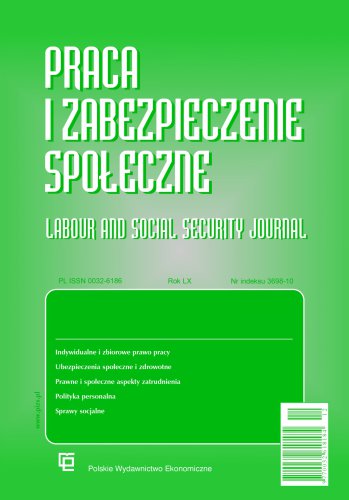Algorithms — a new dimension of supervision and control over employees
Algorithms are becoming the key technology of power over employees. They allow for the
formatting of both the employees themselves and the interactions between them, basically for the
single purpose — optimisation of work processes to increase productivity. From this perspective, the
employees are digital models constructed from data and information. It means that all of their
expressions revealed in the work environment will be measurable in various ways. Algorithms also
sched new light on the issue of subordination in employment. And all thanks to their "blending" into
the biometric data environment of the employees. They somehow acquire attributes of subordination
in employment by combining them with supervisory and control functions encoded in algorithmic
technology. The foregoing means that the functions programmed in this way can be used identically
in any model of employment, and thus in complete isolation from the character of the legal
relationship on the basis of which the work is provided. Therefore, a key question arises, which the
author tries to answer, whether the algorithms can be perceived as tools by which subordination is
created in isolation from the legal basis of the provided work and what consequences it has for the
employees.
References
Bąba, M. (2018). Refleksje wokół prywatności i autonomii informacyjnej jednostki w świecie
internetu (wszech)rzeczy. Współczesne Problemy Zarządzania. Zeszyty Naukowe Wydziału
Informatycznych Technik Zarządzania Wyższej Szkoły Informatyki Stosowanej i Zarządzania pod
auspicjami PAN, (2), 33–51.
Bielak, T. i Ptaszek, G. (2019). Algorytmiczne doświadczenie kultury. Kultura Współczesna, (1), 10.
Ford, M. (2017). Świt robotów. Warszawa: CDP.
Gillespie, T. (2014). Algorithm (digitalkeyword). http://culturedigitally.org/2014/06/algorithm-draft--
digitalkeyword/
Gillespie, T. (2012). The relevance of algorithms. W: T. Gillespie, P. Boczkowski i K. Foot (red.),
Media Technologies: Essays on Communication, Materiality and Society, 167–194. Cambridge: MIT
Press.
Gospodarek, G. (2019). Status ,,niezależnego” usługodawcy a trójpodmiotowy model świadczenia
usług w gig economy — cz. 1. Praca i Zabezpieczenie Społeczne, (2), 9–17.
https://doi.org/10.33226/0032-6186.2019.2.3
Kreft, J. (2019). Władza algorytmów. U źródeł potęgi Googla i Facebooka. Kraków: Wydawnictwo
Uniwersytetu Jagiellońskiego.
O’Neil, C. (2017). Broń matematycznej zagłady. Warszawa: PWN.
Owsiński, W. J. (2018). Dane, informacja, wiedza — niektóre pojęcia i ich zastosowania.
Współczesne Problemy Zarządzania. Zeszyty Naukowe Wydziału Informatycznych Technik
Zarządzania Wyższej Szkoły Informatyki Stosowanej i Zarządzania pod auspicjami PAN, (2), 53–63.
Piwowar, K. (2019). Co widzą algorytmy? Konsekwencje algorytmicznej (nie)widoczności i
(nie)widzialności danych. Kultura Współczesna, (1), 35.
Stefanowicz, B. (2018). Informacja — tajemniczy składnik rzeczywistości. Współczesne Problemy
Zarządzania, Zeszyty Naukowe Wydziału Informatycznych Technik Zarządzania Wyższej Szkoły
Informatyki Stosowanej i Zarządzania pod auspicjami PAN, (2), 9–21.
Tegmark, M. (2019). Życie 3.0. Człowiek w erze sztucznej inteligencji. Warszawa: Prószyński i S-ka.

